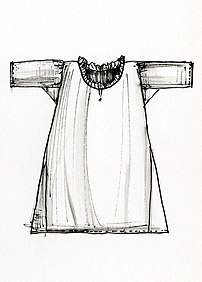What is the Womens Dress Worn With the Leine Called

A drawing of a chemise, laid flat. (2014)
A chemise or shift is a classic smock, or a modern type of women's undergarment or dress. Historically, a chemise was a simple garment worn next to the skin to protect clothing from sweat and body oils, the precursor to the modern shirts commonly worn in Western nations.
Etymology [edit]
The English word chemise is a loanword from the French word for shirt and is related to the Italian camicia or Latin camisia, which, according to Elizabeth Wayland Barber, is likely derived from Celtic.[1]
History [edit]

Marie Antoinette wearing a dress that came to be known as chemise à la reine.
The chemise seems to have developed from the Roman tunica and first became popular in Europe in the Middle Ages. Women wore a shift or chemise under their gown or robe; while men wore a chemise with their trousers or braies, and covered the chemises with garments such as doublets, robes, etc.

This chemise or shift of the 1830s has elbow-length sleeves and is worn under a corset and petticoats.
Until the late 18th century, a chemise referred to an undergarment. It was the only underwear worn until the end of the Regency era in the 1820s,[2] and was usually the only piece of clothing that was washed regularly.
In the eighteenth century, the primary female undergarment was the chemise or shift: a knee-length, loose-fitting garment of white linen with a straight or slightly triangular silhouette. The term chemise was first used to describe an outer garment in the 1780s, when Queen Marie Antoinette of France popularized a kind of informal, loose-fitting gown of sheer white cotton, resembling a chemise in both cut and material, which became known as the chemise à la reine.[3] [4] In the 1810s, the term came also to be applied to an outergarment.[5] In Western countries, the chemise as an undergarment fell out of fashion in the early 20th century, and was generally replaced by a brassiere, girdle, and full slip, and panties first came to be worn.
Men's chemises may be said to have survived as the common T-shirt, which still serves as an undergarment. The chemise also morphed into the smock-frock, a garment worn by English laborers until the early 20th century. Its loose cut and wide sleeves were well adapted to heavy labor. The name smock is nowadays still used for military combat jackets in the UK, whereas in the Belgian army the term has been corrupted to smoke-vest.[ citation needed ]

A late 18th century women's chemise made of linen.
A chemise, shift, or smock was usually sewn at home, by the women of a household. It was assembled from rectangles and triangles cut from one piece of cloth so as to leave no waste. The poor would wear skimpy chemises pieced from a narrow piece of rough cloth; while the rich might have voluminous chemises pieced from thin, smooth fine linen.
Modern chemise [edit]
A modern chemise is generally a woman's garment that vaguely resembles the older shirts but is typically more delicate, and usually more revealing. Most commonly the term refers to a loose-fitting, sleeveless undergarment or type of lingerie which is unfitted at the waist. It can also refer to a short, sleeveless dress that hangs straight from the shoulders and fits loosely at the waist. A chemise typically does not have any buttons or other fasteners and is put on by either dropping it over the head or stepping into it and lifting it up.

As lingerie, a chemise is similar to a babydoll, which is also a short, loose-fitting, sleeveless garment. Typically, though, babydolls are looser fitting at the hips.
See also [edit]
- Camisole
- Kirtle
- Shalwar kameez
- Slip (clothing)
- Smock (disambiguation)
References [edit]
- ^ Barber, Elizabeth Wayland (1994). Women's Work: The first 20,000 Years . New York: Norton & Company. p. 137. ISBN0-393-31348-4 . Retrieved 3 June 2021.
- ^ Scott, Lord. "An Introduction to Ladies' Fashions of the Regency Era". We Make History.
- ^ "Chemise Dress". Encyclopedia of Clothing and Fashion. 2005.
- ^ "Title". Manchester Art Gallery . Retrieved 2021-07-06 .
- ^ "Chemise dress". angelascartier.net.
Bibliography [edit]
- Burnham, Dorothy (1973). Cut My Cote. Royal Ontario Museum. ISBN978-0-88854-046-1. . A survey of shirt patterns over the ages, with diagrams.
- Smith, Kathleen R. (February–March 1987). "A Plain Linen Shift: Plain Sewing Makes the Most of Your Fabric". Threads Magazine.
Further reading [edit]
- "18th-century women's shifts". larsdatter.com. Archived from the original on 2010-12-27. Retrieved 2010-09-01 .
- "How to make an 18th-century chemise". marquise.de.
- "Women's smocks in the 13th-15th centuries". larsdatter.com. Archived from the original on 2010-10-15. Retrieved 2010-09-01 .
External links [edit]
Source: https://en.wikipedia.org/wiki/Chemise
0 Response to "What is the Womens Dress Worn With the Leine Called"
Post a Comment